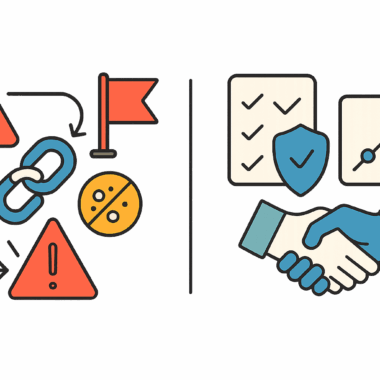

Common Affiliate Program Mistakes and How to Avoid Them

Content:
- Vague Goals & KPIs
- Weak Tracking & Attribution
- Overpaying for Non-Incremental Sales
- “Spray-and-Pray” Recruitment
- Poor Onboarding & Enablement
- Inadequate Compliance & Brand Protection
- Missing Fraud Prevention
- Conclusion
- FAQ
Even well-funded programs underperform when operational discipline lags behind growth. The most common affiliate program mistakes stem from fuzzy objectives, brittle tracking, and weak governance. These gaps compound as the partner base expands: attribution gets noisy, payouts drift from value, and compliance incidents erode trust. The cost is real—margin leakage, inflated CAC, and slower cash cycles.
This article provides a practical, operations-first framework to diagnose failures and apply durable fixes. Each section outlines the symptoms to watch, the impact on unit economics, and specific countermeasures you can automate. The goal is a channel where KPIs, attribution, and fraud prevention work in concert, enabling scale without proportional headcount.
Vague Goals & KPIs
Automation cannot rescue a strategy that lacks measurable outcomes. Define a clear KPI tree that maps the program’s goal—acquisition, basket growth, retention—to concrete indicators such as CAC/LTV, net contribution margin, and validated incrementality. Document owners, formulas, and refresh cadence for every metric; publish a data dictionary so finance, analytics, and partnership teams reference the same definitions.
Translate strategy into enforceable guardrails. Set partner-type targets (content, coupon, influencer), minimum AOV thresholds, acceptable return-rate ceilings, and lookback windows by category. Configure alerts when variance breaches defined bands (e.g., ±10% for three days). When numbers drift, the team knows exactly what to inspect—offer mix, traffic quality, or policy compliance—rather than debating definitions.
Minimum KPI set for most programs
- Acquisition efficiency: CAC, payback period, contribution margin.
- Quality: New vs. returning customer mix, refund/chargeback rates.
- Path value: Assisted conversion share, average touch position, incremental lift.
- Operations: Time-to-first-sale for new partners, approval SLAs, payout aging.
Weak Tracking & Attribution
Misconfigured tracking creates disputes and misallocates budget. Standardize instrumentation with server-to-server postbacks, unique conversion IDs, cross-domain support, and privacy-safe identity stitching where permitted. Version your event schema; require fields such as order ID, net revenue, currency, tax, and consent string. Queue ingestion with retries and idempotency to survive traffic spikes without duplicates.
Attribution determines who gets paid and which partners scale. Move beyond default last-click by applying partner-specific lookbacks, channel priority rules, and position-based weighting for upper-funnel content. Produce daily path summaries and reconcile totals with analytics and finance; investigate when variance exceeds a defined threshold. Model changes should be versioned, with a change log shared to stakeholders for auditability.
Tracking risks & fixes (quick diagnostics)
|
Risk |
Symptom |
What to Check |
Fix to Implement |
| Pixel-only tracking | Drops during ITP/ETP or ad blockers | Conversion vs. finance mismatch | Add **S2S postbacks** with idempotent order IDs |
| No de-duplication | Double-paid conversions | Same order ID across channels | Enforce unique keys; channel priority rules |
| Uniform lookback | Coupon steals brand sales | High last-click on brand weeks | Shorten coupon windows to 1–3 days |
| Unversioned schema | Silent data loss | Missing currency or consent fields | Versioned payloads; schema validation in CI |
Implementation checklist
- Validate postback delivery success and latency daily.
- Compare platform vs. BI totals; keep variance <1%.
- Log attribution decisions with the applied rule set for every conversion.
Overpaying for Non-Incremental Sales
Flat commissions reward proximity, not contribution. Align payouts with value by building a commission engine that accounts for SKU margins, customer status (new vs. returning), and last non-affiliate touch. Require contribution thresholds before full credit unlocks—e.g., content partners must appear above a given path position share or assist rate to earn bonuses.
Tune policies to campaign context. During brand-heavy periods, automatically shorten coupon/tool-bar lookbacks and reduce last-click rates for cart-recovery traffic. Export a weekly variance report that contrasts actual commissions against a naïve last-click baseline; the delta quantifies savings from your rules, turning policy into measurable ROI.
Playbook to stop overpayment
- Define partner tiers and map rates to incremental behaviors (new customer, new category, high-margin SKUs).
- Cap assisted credit to prevent runaway multi-touch payouts.
- Block low-margin SKUs or apply haircuts to protect contribution.
- Review “brand collision” outliers weekly; adjust rules where leakage persists.
“Spray-and-Pray” Recruitment
Unfiltered outreach fills the roster with low-fit sites that drain support time and introduce compliance risk. Replace volume emails with ICP-driven discovery that scores candidates on audience match, traffic provenance, geography, content quality, and historical conversion proxies. Only high-fit prospects receive tiered invites with clear expectations and aligned incentives.
Operationalize recruitment as a repeatable funnel. Automate KYC and traffic checks at application, assign a provisional tier, and provision starter assets immediately upon approval. Schedule 14- and 30-day performance reviews with promotion or pause criteria. This approach preserves manager bandwidth for strategic partnerships while maintaining a steady pipeline of quality publishers.
Signals that predict fit
- Audience overlap by category and search intent.
- Clean traffic sources (low data-center ASNs, stable geo mix).
- Content velocity and historical engagement (time on page, bounce).
Poor Onboarding & Enablement
Slow or manual onboarding delays revenue. Build self-serve enablement: a link builder, deep-link validator, coupon/code assignment, and a creative library with expiry metadata. Add pre-flight checks that confirm tags fire, postbacks acknowledge, and product feeds carry price and availability. If any check fails, show a precise remediation path in the partner portal.
Enablement should continue after go-live. Send data-driven playbooks by tier and region, share seasonal calendars, and refresh creatives automatically before promotions. Track operational KPIs—time-to-first-sale, time-to-first-$1k, and ratio of approved-to-pending offers—to measure friction. Continuous enablement shortens ramp time and increases active partner share.
Onboarding essentials
- Dynamic product feeds (hourly/daily), with currency and stock fields.
- Sandbox testing for links and postbacks without polluting reports.
- Knowledge base with short videos and searchable troubleshooting.
Inadequate Compliance & Brand Protection
Policy gaps scale into brand damage. Enforce brand protection with automated keyword monitoring for search ads, domain/subdomain checks, and checkout code whitelists. When violations occur—brand bidding, unauthorized couponing, geo breaches—open a case automatically, attach evidence (screenshots, SERP logs), and place commissions on hold pending review.
Compliance must be lifecycle-wide. During onboarding, block prohibited content categories and require clear disclosure. In flight, apply velocity rules to coupon usage and detect anomalous referral paths. Post-conversion, keep immutable audit logs for every enforcement action. Strong evidence management reduces disputes and accelerates resolution, protecting margin and reputation.
Core controls to implement
- Code whitelists at checkout with API-level enforcement.
- SEM monitoring with progressive penalties and automatic deactivation for repeats.
- Time-boxed probation for new partners with stricter thresholds.
Missing Fraud Prevention
Fraud scales faster than teams unless controls are layered. Deploy fraud prevention that combines device and IP reputation, ASN filtering for data centers, click velocity thresholds, and session integrity checks. Score events in real time; route high-risk traffic to manual review and withhold payouts until cleared. Tune thresholds to balance false positives against loss exposure.
Make evidence collection automatic. Store raw click/conversion logs for at least 24 months, hash sensitive identifiers, and expose partner-facing dashboards explaining adverse decisions. Run periodic re-scoring when models improve and claw back or release funds based on updated outcomes. The target is a measurable drop in chargebacks, a stable CPA, and predictable approval cycles at higher volumes.
Layered defenses
- Bot detection with human verification on spikes.
- Duplicate order suppression by ID and device fingerprint.
- Geo-velocity checks and proxy/VPN identification.
- Partner-level throttling with progressive cooldowns.
Conclusion
High-performing programs are built on clear KPIs, resilient attribution, aligned commissioning, and rigorous compliance. Treat each failure mode as an engineering problem: define the symptom, quantify the impact, and implement a rule, workflow, or guardrail that prevents recurrence. Document decisions and version your policies so changes are auditable and reversible.
Adopt an iterative operating cadence. Fix tracking first, then align commissions to contribution, automate recruitment and onboarding, and harden fraud prevention. Review results weekly with finance and analytics, and retire manual steps once automation proves stable. The compound effect is a scalable, margin-safe channel that withstands growth.
FAQ
Do I need analytics if my affiliate platform has reports?
Yes. Use analytics/BI for cross-channel validation, cohort analysis, and incrementality estimates. Treat the affiliate platform as the payout ledger and reconcile totals nightly.
What is a reasonable lookback window by partner type?
Coupon/tool-bar: 1–3 days. Content/influencer: 7–14 days. Subscription trials or high-consideration purchases: 14–30 days. Adjust during brand-heavy campaigns to prevent collision.
How long should a pilot run to validate fixes?
Two to four weeks is sufficient if you reach statistically meaningful volumes—thousands of clicks and hundreds of conversions per key partner type—with at least one brand-collision scenario.
Pixel vs. server-to-server postbacks—what to prioritize?
Prioritize **server-to-server postbacks** for reliability and privacy alignment. Keep a client pixel as a fallback; enforce idempotency with unique conversion IDs.
How can I reduce disputes over commissions?
Publish commission logic, log attribution decisions, and provide partner-visible evidence (path data, rule applied, timestamps). Add a structured appeal workflow with defined SLAs.

Best B2B Customer Acquisition Strategies in 2025 – The Full Guide
The B2B customer acquisition landscape is undergoing significant changes in 2025. As decision-making processes grow more complex and digital channels evolve, businesses must adapt their strategies to remain competitive. Buyers are more informed, expect personalized experiences, and increasingly prefer remote or digital-first interactions.

How to Build a Scalable Affiliate Program from Scratch
In this guide, we outline the critical steps to create a scalable, high-performance affiliate infrastructure—from goal setting to automation. Each phase is designed to ensure transparency, operational efficiency, and long-term partner satisfaction.

How to Find Competitors’ Affiliates Effectively with 9 Easy Ways
In the increasingly competitive world of affiliate marketing, knowing who promotes your competitors can offer a decisive edge. Understanding which affiliates are driving traffic and conversions for rival brands enables you to reverse-engineer their success and identify high-potential partnership opportunities.



